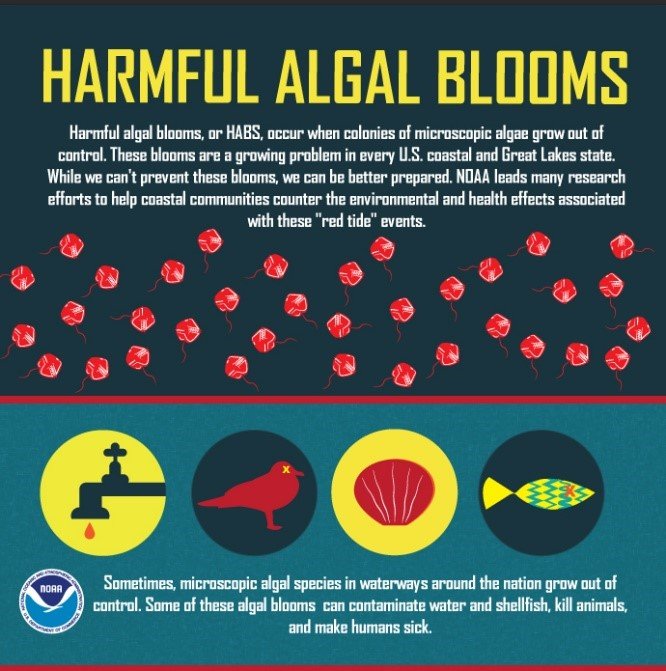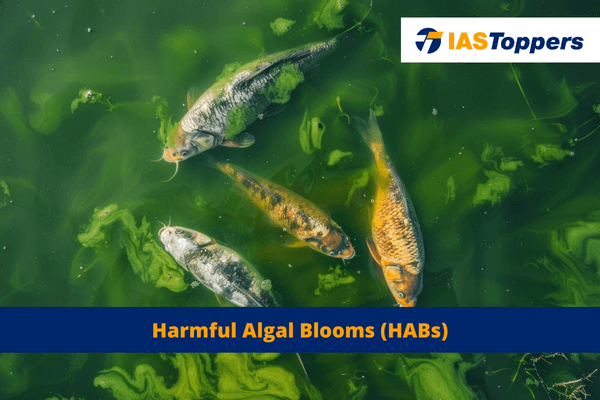Harmful Algal Blooms are caused by colonies of algae which may have serious consequences on the environment. In this article, you will learn harmful algal blooms definition, harmful algal blooms causes and impacts and detection providing key insights for GS Paper-III Environment and Ecology section of UPSC IAS Exam.
Table of Content
- What are algae?
- What is Harmful Algal Bloom?
- Causes of Harmful Algal Blooms
- Why is an algal bloom harmful?
- How are people exposed to harmful algal bloom?
- What are the harmful algal blooms effects on humans?
- Harmful algal bloom species and their impacts
- Government initiatives to control Harmful algal blooms
- Conclusion
- Frequently Asked Questions
- Reference
What are algae?
- Algae are microbes that resides in aquatic habitat and primarily performs photosynthesis to derive energy from sunlight.
- Algae are single-celled organisms that plays a vital role as basic components of food chains in aquatic habitat.
- Algae are type of phytoplankton that can survive in various aquatic habitat such as salt water, fresh water, and a mixture of both- brackish water.
- Certain varieties of algae have the ability to generate toxins.
- Some algae are not toxic but they may consume all the dissolved oxygen (DO) in the water as they decompose.
- This may obstruct the gills of fish and invertebrates, and suffocate corals and underwater plants.
- Factors responsible for production of these toxins are light, temperature, salinity, pH, and nutrient levels in the environment.
- The release of algal toxins into the water or air can impact humans, animals, fish, and other organisms of the ecosystem.

What is Harmful Algal Bloom?

- Harmful algal blooms or HABs is the excess growth of toxin producing algae in colonies.
- In favourable conditions, algae can multiply so much that it can lead to toxins producing “blooms”.
- The colour of algae helps determine the types of Harmful Algal Blooms.
- Some algae discolour water, creates unpleasant-smell and contaminate drinking water.
- Cases of human illnesses caused by HABs are rare but they can have severe consequences or can even lead to death.
- Excess growth of makes algae visible to the naked eye.
- Harmful algal blooms can be green, blue-green, red, or brown, which depends on the type of algae.
Causes of Harmful Algal Blooms:
- Harmful Algal Blooms may occur naturally but anthropogenic activities may contribute to their increased frequency and intensity.
- Factors such as excessive nutrient input, pollution, changes in food chains, the introduction of non-native species, modifications in water flow, and climate change all plays a role in the growth of algae.
- The excessive nutrient inputs are fertiliser sources such as lawns and agriculture, sewage water or other organisms in waterbody that produces such nutrients.
- Certain algal species may also thrive under favourable wind and water currents.
- HABs may also be caused by “overfeeding” or an excessive influx of nutrients mainly phosphorus and nitrogen from fertilisers.
- These nutrients accumulate at a rate that exceeds the normal capacity of algae in the environment.
- HABs can also occur due to natural events such as poor water circulation, very high–water temperatures, and extreme weather phenomena such as hurricanes, floods, and droughts.
- Though HABs are present in all coastal states, the specific algae involved and the problems associated with it vary across different locations.
- Some factors such as coastal structure, water runoff, oceanography, and the presence of other organisms in the water can also influence the extent and severity of HAB impacts.
Why is an algal bloom harmful?
- HABs can harm the environment by reducing the oxygen levels in the water, this may result in the death of fish and other aquatic animals.
- HABs that occurs near the water’s surface can obstruct the penetration of sunlight, this may affect other aquatic plants that are present deeper in the waterbodies.
- HABs can have serious economic impact on fisheries and tourism sector areas due to reduced fishing and lack of aesthetic sense in the region where HABs occurs.
- Certain HABs are linked to severe health consequences.
How are people exposed to harmful algal bloom?
- Humans can be exposed to toxins through various sources such as consuming fish that has grown in harmful algal bloom or while swimming in or while consuming the water or while inhaling the air.
- Cooking contaminated seafood or boiling water having HABs cannot eliminate the toxins from them.
Cyanobacterial Harmful Algal Blooms:

What are the harmful algal blooms effects on humans?
- Depending on the types of algae, HABs can cause severe health consequences including death.
- Example:
- The consumption of seafood contaminated by toxins from Alexandrium algae can lead to paralytic shellfish poisoning, which can cause paralysis or death.
- Pseudo-nitzschia algae produces a toxin called domoic acid, which when consumed in high amounts can cause vomiting, diarrhoea, confusion, seizures, permanent short-term memory loss, and even death.
- HABs that occur in freshwater are mainly caused by the cyanobacteria Microcystis.
Harmful algal bloom species and their impacts:
| Organism | Water Type | Colour | Toxin | Health effects |
| Alexandrium sp. | Salt | Red or brown | Saxitoxins | Gastrointestinal (nausea, vomiting), and neurological (a floating sensation, headache, or muscle weakness) |
| Cyanobacteria | Fresh | Blue-green | Cylindrospermopsin | Nausea, vomiting, diarrhoea, abdominal tenderness, pain, or acute liver failure |
| Gambierdiscus | Salt | Orange | Ciguatoxins | Nausea, vomiting, diarrhoea, or stomach pain |
| Karenia brevis | Salt | Red | Brevetoxins | Gastrointestinal illness, muscle cramps, seizures, paralysis Respiratory problems, especially for asthmatics |
| Pseudo-nitzschia | Salt | Red or brown | Domoic acid | Vomiting, head weaving, nausea, seizures, diarrhoea and abdominal cramps, bulging eyes, or headache |
| Microcystis | Fresh | Blue-green | Microcystin | Gastrointestinal illness, liver damage |
Government initiatives to control Harmful algal blooms:
- Harmful algal blooms in India is being monitored via cloud-based dashboard called “CyanoKhoj”.
- CyanoKhoj is an early warning system thatuses satellite data to monitor harmful algal blooms in inland waterbodies of India.
- Algal Bloom Information Service is an initiative of Indian National Centre for Ocean Information Services whose targeted users are fishermen, fishery resource managers, researchers, ecologists and environmentalists.
- Algal Bloom Information Service monitors algal blooms in North Indian Ocean
Conclusion
HABs pose significant threats to aquatic ecosystems and human health. The HABs can result in the production of toxins that may have detrimental effects on marine life, water quality, and the overall balance of ecosystems. The impacts of harmful algal blooms vary from ecological consequences to economic losses and to risk on human health. Hence, it is crucial to monitor, prevent, and manage these blooms through effective strategies and collaborative efforts to safeguard both the environment and human populations from its harmful effects.
Ref: Source-1
| Other Articles in Environment & Disaster Management | |
| Eutrophication | Microplastics |
| Ocean Acidification | Plastic Waste Management |
| Eco Sensitive Zone (ESZ) in India | Liquid Nano Urea |
FAQs (Frequently Asked Questions)
What are harmful algal blooms?
Harmful algal blooms or HABs is the excess growth of toxin producing algae in colonies.
Are all algal blooms harmful?
Not all algal blooms harmful but even sometimes non toxin producing algal blooms can reduce the dissolved oxygen in waterbodies.
How can algal blooms be harmful?
It reduces the oxygen levels in the water leading to death of water organisms, reduces fish production thus harming the economy and effects tourism setor.
How to prevent harmful algal blooms?
By using only the recommended amount of fertilizers, by not littering around the water bodies and reducing the amount of nutrients run off into nearby water bodies.
What causes harmful algal blooms?
Excessive nutrient input, pollution, changes in food chains, the introduction of non-native species, modifications in water flow, climate change among others leads to HABs.

